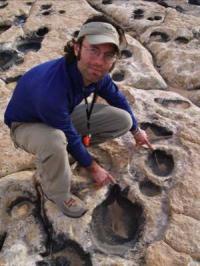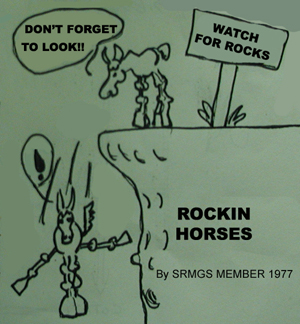| SRGMS Newsletter | November 2008 |
|
Sorry everyone, the weekend adventure I had planned I just learned can only be done in dry season. :o( So pull out your fuzzy blanket and grab your your willing (or unwilling) partner to ohh and
ahh as you revisit the row of rocks on your book shelves, coffee tables, in a box in the closet, the box in the garage and even the wet shiney one outside under a pile of leaves. :o)
In the mean time- here's a few photos taken by John K. of our picnic last month at Rodney's Place. It is an AMAZING location and a FANTASTIC afternoon with a GREAT group of friends.
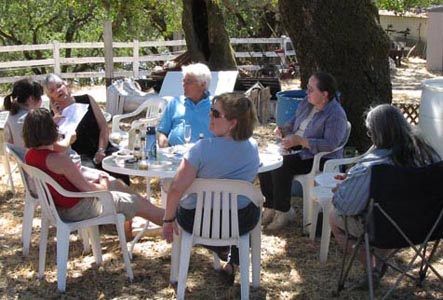 A gathering of THE MINDS: If you listen closely it sounds like gravel in a tray. :o) *Notice who is "leading the discussion".*
|
|
|||||||||||
|
In The News... Geologists' discovery: Was S. Utah site of a dance of the dinosaurs? A new study by University of Utah scientists describes a site with thousands of fossilized dinosaur tracks and tail drag marks dating to the Jurassic Period. The site is on BLM land and is open to the public but permits are required to visit the area. Winston Seiler noticed something strange about the network of holes that pocked the sandstone he was studying in Paria Canyon-Vermilion Cliffs Wilderness Area. While doing field work measuring the red colorations of Navajo formation in 2006, the University of Utah geology graduate student had an epiphany as he stared at hundreds of these seeming potholes. "I was perplexed by what I was seeing," Seiler recalled. "There were these mounds that were pushed up around each of the holes. The mounds would have to form when the sand was still soft. I saw patterns that were repeating themselves. There was this lemon-drop impression that didn't fit in with potholes."
His intuition suddenly told him the Dino tracks depressions were not erosion-caused potholes, common in sandstone, but rather impressions left by hordes of dinosaurs. Two years
of further study corroborated his hunch, documenting what may have been a veritable "dinosaur dance floor" recorded in the three-quarter-acre site, according to findings Seiler published
this month in the paleontology journal Palaois.
This dinosaur "trample surface" is different than another recent find near Coral Pink Sand Dunes, although both were found in 190 million-year-old Navajo sandstone. This formation, hundreds of feet deep in places, is comprised of iron-rich windblown sand, deposited when a vast desert covered the region. At the time, this region occupied tropical latitudes, approximately 10 degrees north. Seiler documented four different types of prints at the site, indicating that both fleet-footed three-toed carnivores and lumbering sauropod plant eaters of varying ages crossed this location. "It tells us about social behavior, who is dancing together," said co-author Marjorie Chan, the U. geology professor who first saw the holes in 2005. She had directed Seiler to the spot to gather data for her work measuring the redness of some of the most colorful rock in canyon country. Of further intrigue are sinuous drag marks apparently left by the dinosaurs' tails. "We think of tails as a counterbalance to the upper part of their body, so they are not usually dragging their tails," said Seiler, now an oil company geologist in California. "It could have something to do with the environment." The geologists believe the site was part of a soggy network of oases in a sea of sand dunes, indicating a gathering place for dinosaurs in an otherwise uninhabitable landscape. The sand was not only wet enough to record footprints, but was easier to walk on and may indicate the presence of algae, said Jim Kirkland, a paleontologist with the Utah Geological Survey. "Here is the biggest desert we have in the world's history. We have these stacks of sand and here's the surface that's just trampled by dinosaurs," said Kirkland, whom Seiler consulted for his study. "Because these tracks are preserved it shows there was a high water table." The dense patchwork of prints averages 12 per square meter. The bottoms of the holes tilt in one direction, suggesting the ancient reptiles were moving in a south to southwest direction, perpendicular to the wind, whose direction is recorded in the formation's striations, according to Chan. "You're looking for anything that looks different. As sedimentary geologists we are already focusing on details that give clues about the environment," said Chan, who chairs the U.'s department of geology and geophysics. "It's pieces like these that add to the puzzle, that will help us understand how and why dinosaurs lived in this desert," she added. "That's the serendipity of science. That's what makes it fun."
Note: There is a four-month wait for the 10 permits issued daily by phone or online. Call the BLM's St. George office at 435)-688-3246. An additional 10 permits are
issued daily, one day in advance of the hike, during a 9 a.m. walk-in lottery March 15 to Nov. 14 at the Paria Contact Station and Nov. 15 to March 14 at the BLM's Kanab Field Office.
November Birthstones - Topaz Smoky Quartz or Citrine are often used an alternative to topaz because it appears in many of the same colors as topaz. Unlike topaz, smoky quartz and citrine are readily available and inexpensive even in large sizes. Kissed by the Sun... As the golden variety of the quartz family, citrine takes its name from citron, the French word for lemon. But don't think that all citrine is the color of lemonade. Citrines range from the soft hues of golden champagne to the rich, deep color of a fine Madeira wine. Its broad range of colors and outstanding affordability make citrine one of the most popular and desirable gemstones in the world. Citrine is a gemstone that generates a feeling of warmth and often sparks an attitude of lightheartedness in the wearer. Sunny and affordable, citrine is the perfect complement to any jewelry wardrobe, blending especially well with pastel colors and bright, polished surfaces. Citrine is also readily available in larger sizes. It's not uncommon to find beautiful faceted gems over 10 carats, especially in lighter shades of yellow. Origins
Treatments
|
|
Years of Experience Shared... Cabochon Cutting for Beginners - Polishing Almost any properly sanded stone will begin to show a polish within seconds; if it doesn't the surface has not been properly sanded or the wrong powder-buff combination is being used. Leather is probably the most popular buff and is by far the best for stones that undercut. Other buffs are felt, muslin, Pellon, wood, cork and many many others. Mix a small amount of polishing agent with water and apply sparingly to the buff. Apply only a SMALL AMOUNT. If too much is used polishing action is slowed down. It may even "ball up" and cause scratches on the stone. As with sanding, keep the cabochon moving at all times while polishing and go over every part of the surface. Use heavy pressure and add a small amount of polishing mixutre every few minutes. Heavy pressure is necessary to achieve a polish. However, pressues creates heat, so the stone must be checked every few seconds. The heat will cause some stones to crack and heat buildup can be enough to soften the dop wax, causing the stone to come off the dop stick. The polish is usually achieved when the buff has become almost dry. Heat will build up rapidly at that point, so it is important to check the stone every few seconds. Wipe the surface clean and dry frequently with a tissue or clean cloth and insepect carefully under a strong light. A severe test for a good polish is to use a five to ten power magnifying glass to check the surface. A perfectly polished surface is almost impossible to see under magnification. Manification will show even the tiniest scratches, and they must be removed to achieve a perfect polish.
|
| SRGMS Newsletter | Continued |
|
Fees are based upon $10/hr instruction. 30% of all class fees are turned over to SRMGS.
Egyptian Sprial Chain- 4 hours
Byzantine Chain - 4 hours
Remember to check the website to see the full class schedule list (includes additional months). You can find this under EVENTS -> CLASSES.
1 (low) to 5 (high).
Next trip
Kendra is trying to organize a Group Rate that requires prepayment for bulk tickets.
We will be carpooling from SRMGS Workshop Leaving at 9:50am.
|

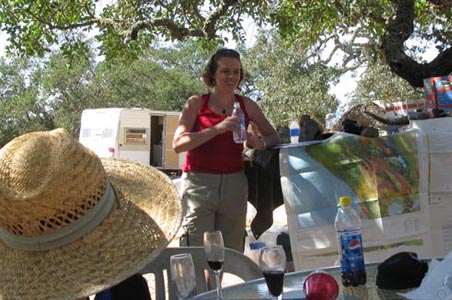
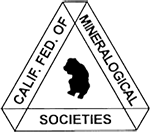
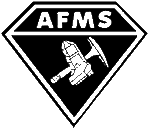 We love to have more active members. Attend one or more of the SRMGS Meetings to get the most out of your membership! Meetings are held at the SRMGS Workshop.
We love to have more active members. Attend one or more of the SRMGS Meetings to get the most out of your membership! Meetings are held at the SRMGS Workshop.
